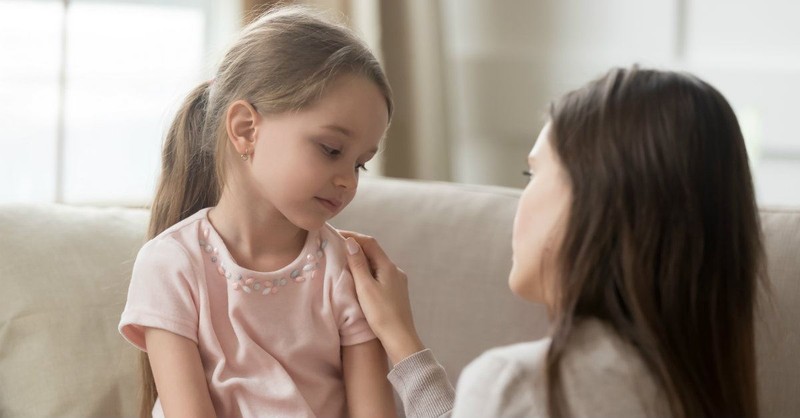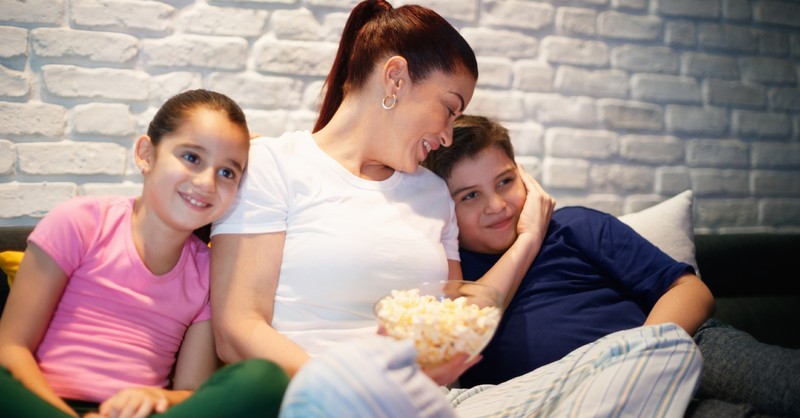
It’s OK to be afraid momentarily, but we don’t have to live scared, “for God gave us a spirit not of fear but of power and love and self-control” (2 Timothy 1:7 ESV). When Peter walked on the water, Jesus reached for him immediately as he began to sink. Immediately. God is not surprised by our fear, nor the current pandemic. Our God goes before us, behind us, and remains with us, always. Jesus, our Savior, knows our fears intimately. People of great faith are wrestling with fear right now. Our children are no different. We don’t have to supply all of the scholarly answers for them. The most important thing Jesus told us to do was to love one another. Parents, caregivers, educators, counselors, and coaches—all those whose lives border and influence a child’s—love is the way through this.
John Piper, in his message “How to Talk to Children About the Coronoavirus,” referenced Matthew 4:24: “They brought [Jesus] the sick, those afflicted with various diseases and pains … and he healed them” (ESV). Love, in Christ, is our comfort. He is steady when our world has been rocked. He is constant, calm, and comforting. In the midst of the storm, when we are sinking, immediately, He is there. “Jesus is more powerful than diseases—every one of them,” Piper teaches.
Here are 10 ways we can help kids cope during the COVID-19 pandemic.
Photo Credit: © Pexels/Ba Phi

1. Talk about COVID-19
There are quarantine rainbows and teddy bears popping up in windows, and sidewalks chalked with traces of hope all over our small town and the many others across the world. Walking the neighborhood in search of them can help kids take their minds off of the seriousness and heaviness of the current crisis we are all living through. But equally important is talking about what’s happening. As parents and caregivers, we don’t have all of the answers ourselves.
Limit news exposure, but stay updated through reliable sources like The Center for Disease Control. “Teach children everyday actions to reduce the spread of germs,” the CDC recommends, and they provide practical guidelines here. “Limit your child’s exposure to media coverage, based on their developmental level,” writes Chad Kraska for TGC. “Our job as parents is both to navigate the complex web of information/misinformation and to assure our kids that we’re staying informed and will get them the information they need.”
Look to the word of God for hope each day, and listen the voices of wisdom God has placed in our lives through gifted pastors, speakers, teachers, leaders, mentors and writers. The wisdom we pour into our children starts with our daily seeking of God. “God is perfectly wise,” John Piper says in his message, “How to Talk to Children About the Coronoavirus,” “That means he knows exactly what needs to be done to bring about what’s best for all time. That’s called wisdom.”
Photo Credit: © Getty Images

2. Listen to Them
There are a million thoughts racing through our minds, and the last thing we feel capable of is absorbing anyone else’s worries or fears. But our children need us to listen to their concerns and fears. “Make time to talk,” the CDC advises, “Be sure children know they can come to you when they have questions.” Their worries and disappointments matter deeply to them, and to our Father in heaven.
As their parents and caregivers, we have been placed purposefully in their lives to comfort them in these moment. Listening to them is a big way to express our love and care for them. When they understand no problem or concern is too small for us to listen to and acknowledge, they are more apt to keep talking to us. This is much healthier than holding big emotions in. “Anything that’s human is mentionable, and anything that is mentionable can be more manageable. When we talk about our feelings, they become less overwhelming, less upsetting and less scary,” said Mister Rogers.
Photo Credit: © Getty Images/fizkes

3. Let Them Linger Close
Children are watching to know how they are supposed to deal with this new and unexpected “normal.” Even though we cannot give them all of the answers they seek, we can still be a voice and presence of calm and stability for our children. When I feel overwhelmed, I calmly sit in prayer on the floor in my room. I allow tears to fall, and my Savior Jesus to minister to my heart the way only He can comfort me. When my daughters find me sitting with God when I am sad or scared, it leads them to His feet. When I lose my patience due to my own overwhelming feelings, I apologize to them. Every note of comfort and wisdom I have to share with them comes from Him.
“In many ways,” wrote Chad Kraska for The Gospel Coalition, “how we manage our own anxiety will transfer to how we are (or are not) able to appropriately care for and shepherd others, including our children.”
“I’m disappointed I can’t go see my parents and I miss them terribly,” or, “I am worried about my friend’s daughter who is a nurse treating patients with COVID-19,” are OK sentiments to share with our children. Model the normalcy in expressing emotion appropriately, rallying to carry on, looking for the positives and ways to be grateful, and remembering God’s truth amidst crisis. It shows our children what do do when they feel those fears, worries, disappointments and anger over all of the change and missing pieces and people in their lives.
Photo Credit: © Getty Images/diego cervo

4. Prompt Them to Share Their Emotions
I’s OK to urge our children to let the tears fall if they feel the need to cry, or to express anger and frustration over a new challenge, or an activity or friend they miss. “The most important thing to be aware of as we talk with them is our tone of voice and the spirit from which we speak,” writes Seth Dahl, a longtime children’s pastor, “If I am fearful, I will instill fear no matter how well I filter the news or relay statistics.”
Validating our children’s feelings, and allowing them to name them, lessens the pain of an open wound. “Don’t be surprised if they are more irritable and touchy,” writes Erin Walsh, M.A. and David Walsh, Ph.D., for Psychology Today, “Be extra patient.” None of us can pretend everything is OK right now, and our children can sense it. Age appropriately, we can prompt them to express their emotions in a healthy way. Make time to acknowledge the emotions children are feeling, allow them to name and feel them fully, and fill them back up with reminders that they are loved, things to be grateful for, and look forward to.
Photo Credit: © Getty Images

5. Remind Them We Are All in This Together
We are all in this together. This phrase is becoming commonplace, and it’s absolutely true. As the COVID-19 pandemic continues on, many of us will personally know people sick with the disease, or someone working on the frontlines to help treat the sick. Still more essential workers are still venturing out into the world, taking risks to serve others. Teachers are figuring out how to teach virtually and parents how to homeschool and work from home. There are many difficult situations happening, and they are touching our lives, personally, now more than ever. These aren’t just people we hear about, they are our family and friends. Children need to know we truly are all in this together.
Photo Credit: © Getty Images/monkeybusiness

6. Pray Together
Prayer is powerful. It is a huge weapon in the war against the COVID-19 pandemic. We can, and should, pray over every emotion and challenging conversation or blow up we have with our children. If we can start every day with prayer, and end some of the trying moments we are experiencing with prayers to do better, we will all draw closer to God. Consider setting up specific times in the daily schedule to pray, whether it’s quiet time to read a devotion in the morning, prayers around the dinner table at night, or praying over our children before they go to sleep at night. Prayer is powerful. God hears our prayers. He is close to the broken-hearted. He is the God of miracles. Keep praying for the healing of people with COVID-19, for a cure, and for the stop of its spread.
Photo Credit: © Getty Images

7. Prioritize Rest
Sleep is beneficial for many reasons, including the immune system. Making sure kids are getting enough sleep each night is important for their physical and mental health. “Try to continue normal home routines, especially at bedtime,” writes Erin Walsh, M.A. and David Walsh, Ph.D., for Psychology Today. Depending on the daily schedule, allowing elementary students to wake on their own might be a good way to bolster their defenses.
I have noticed an increase in tiredness from my own children, just from the emotional toll the pandemic is taking on them. They miss their friends, their teachers, and their extra curricular activities. The pendulum sways from having too much built up energy they are used to exerting, to a crash from the emotional toil the isolation is having on them. Every family, child, and home is different, but prioritize rest when possible.
Photo Credit: © Getty Images/Vasyl Dolmatov

8. Meet Nutritional Needs as Best as Possible
Many children rely on school for breakfast and lunch. There are schools and food banks passing out meals for students. Look for local resources meeting those needs. Attempt to provide kids with three meals a day, and light snacks in between. For the sake of everyone’s sanity, if it is possible, create a routine to be loosely followed each day.
Kids of all ages cope better when they know what to expect. It helps parents and caregivers too. Now that my kids aren’t carrying their water bottles around school, they often forget to drink water. Consider filling up a certain water bottle or cup each day, and encourage them to refill it often. Staying hydrated is important to our physical health, and also helps keep our minds sharp.
Photo Credit: © Getty Images/Tatiana Atamanuik

9. Stay in Contact with Friends and Family
The sight of actual faces is a blessing during this time of quarantine and isolation. It’s important to keep in contact with the people we love, care about, and are used to seeing, even though we are not able to be together physically. We were not meant to do this life alone, and God has placed people in our lives purposefully. It’s important for us to make extra efforts to help our children connect to friends and family. There are free video meeting platforms that allow many people to talk at one time, creating a great opportunity to feel the togetherness that will help all of us get through this. Find a way to see the faces of the ones our children love and miss.
Photo Credit: © Getty Images/halfpoint

10. Keep Moving
The Spring flowers are coming up, even though we remain isolated from each other. Much has changed in our daily lives, but Spring is still coming. Keep children moving, noticing the buds coming up through the ground, and anticipating the warmer weather the sunnier days will bring. Rest is important, but so is exercise. Keep kids moving, not just mentally, but physically.
Schedule recess into the day, go on long walks and encourage them to try some of the fun physical fitness instruction available online right now. It may take some effort to find creative ways for them to move while social distancing, but it’s worth it. It sounds great to say we’ll all try something new during all of this downtime, but start by sticking with what children normally do in their daily routine. Or let them join us in what we would be doing, if it’s age appropriate. Keep it simple, but keep them moving.
Meg writes about everyday life within the love of Christ as an author, freelance writer and blogger at Sunny&80. Her first book, “Friends with Everyone,” is available on amazon.com. She earned a Marketing/PR degree from Ashland University, but stepped out of the business world to stay at home and raise her two daughters. Besides writing, she leads a Bible Study for Women and serves as a Youth Ministry leader in her community. She lives in Northern Ohio with her husband, Jim, and two daughters.
Photo Credit: © Unsplash
Originally published Wednesday, 08 April 2020.









